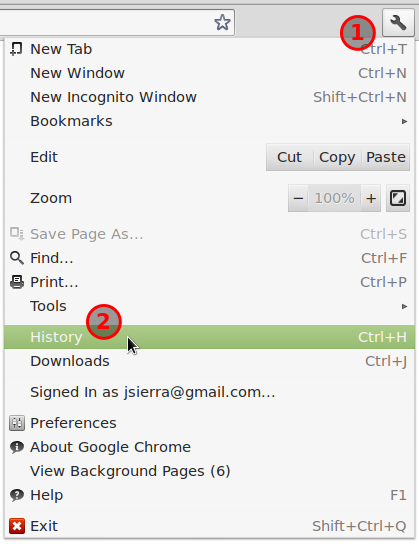

- Google chrome history code#
- Google chrome history download#
- Google chrome history free#
- Google chrome history windows#
Print "Opening history CSV data from", CSV_FILE with open( expanduser( CSV_FILE), 'rb') as f: execute( 'INSERT INTO urls (last_visit_time, url, title, visit_count) VALUES (?, ?, ?, ?)', ( when, url, title, 1)) """ there must be an entry in urls and another in visits for Chrome to recognize the history entry """ c. execute( 'SELECT datetime(last_visit_time/1000000-11644473600, "unixepoch") as last_visited, last_visit_time, url, title, visit_count FROM urls ') """ list existing history in chrome """ result = c. # get a data cursor to work with the database c = conn. path import expanduser import sqlite3 import time, datetime # the CSV data you obtained from somebody else's browser CSV_FILE = "~/Desktop/history.csv" # the place where Chrome stores its history and that we will use # to analyze our source data HISTORY_DB = '~/Library/Application Support/Google/Chrome/Default/History' # open destination database conn = sqlite3. #!/usr/bin/env python # See: import csv from os. Tadam! Your data is now ready for analysis.

Google chrome history code#

14:25:56,"""What Will a Civilization a Million Years Ahead of Earth Look Like?""" 14:25:54, Sagan Quote: All civilizations become either spacefaring or extinct. Once you have exported the data, you should end up with a CSV (Comma Separated Values) file that looks a bit like this one. I haven't tested this because I don't use Windows.
Google chrome history windows#
If you want to get the browser history from a windows browser there are some tools that can help you. Paste this ~/Library/Safari/, and you'll see the History DB file there.ĭatetime( moz_historyvisits. While the file open dialog is open, press Cmd+Shft+G, you will see the Go To Dialog. Open that file with sqliteBrowser, your OSX file open dialog probably will not show the ~/Library directory, that's Apple trying to protect you from yourself.The file containing your Safari history is in ~/Library/Safari/History.db.
Google chrome history download#

Once you locate the file containing the browser's history, copy it to make a backup just in case we screw up. You can work around this by either using the terminal (my preferred method) or by using the Cmd+ Shft+ G in Finder. It tries to protect us from ourselves by hiding some system and application-specific files. The OSX Finder cheats a little bit and doesn't show us all the files that actually exist on our drive. Turns out that most of them, including Safari, have their history saved in some kind of sqlite database file somewhere in your home directory. The harder way, which seems to be what Safari wants is a bit more hacky but it will also work for other browsers.
Google chrome history free#
Unless you are using Safari on OSX, most browsers will have some kind of free plugin that you can use to export the browser's history.


 0 kommentar(er)
0 kommentar(er)
